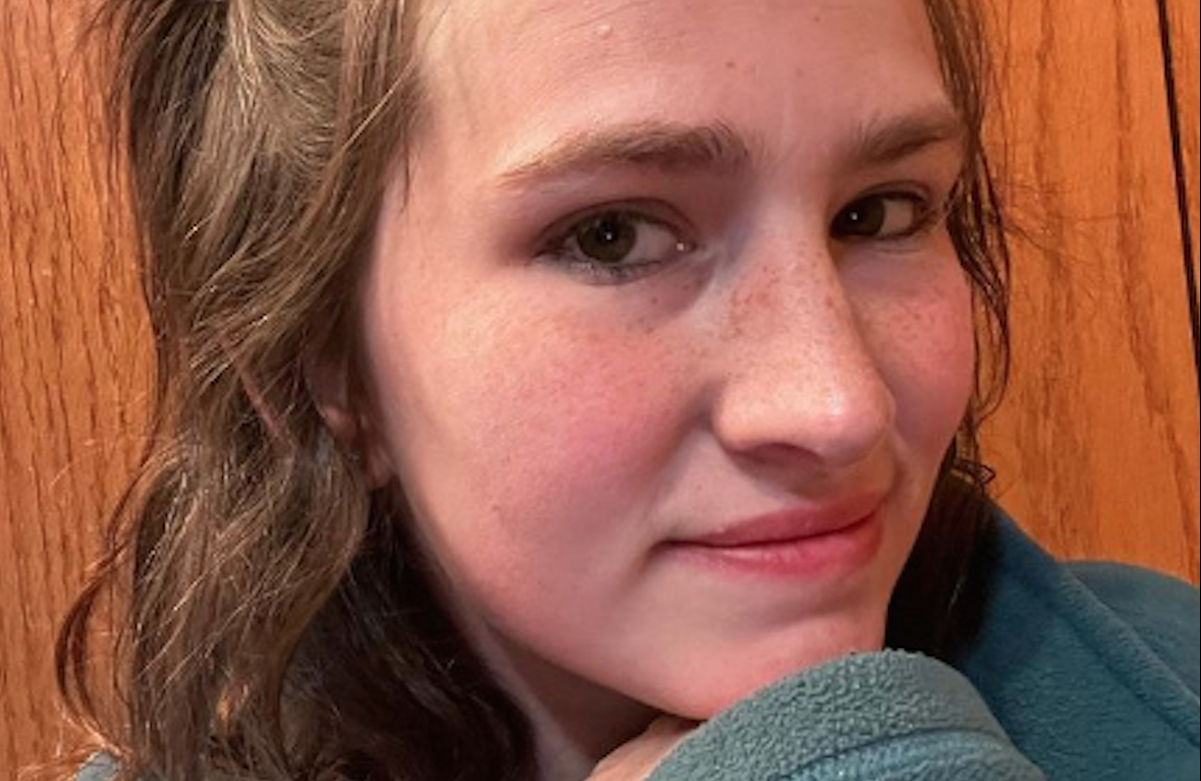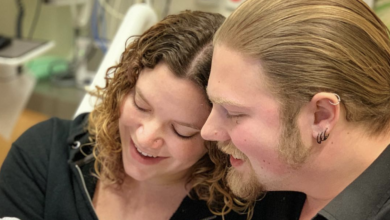Doctors Watching ‘Alaskan Bush People’ Star Bird Brown Closely After 8-Pound Tumor Removed From Ovary Mass ‘Likely’ to Come Back
Doctors Watching ‘Alaskan Bush People’ Star Bird Brown Closely After 8-Pound Tumor Removed From Ovary Mass ‘Likely’ to Come Back
SnowBird Recovery From Tumor Surgery
Afte “Alaskan Bush People” star SnowBird Brown, 28, underwent emergency surgery to remove two precancerous tumors, she said doctors have been watching her closely.
Brown has offered fans an update on her “rough” recovery from the surgery and says she can now lift things again, like hay and her heavy cats.
Ovarian cancer is when the ovaries which produce the sex hormone, estrogen, as well as eggs become cancerous.
Brown was faced with the decision of whether to have a hysterectomy, the surgical removal of part or all of the uterus (or womb), often with the cervix and potentially including the fallopian tubes and ovaries.
A hysterectomy is used as a treatment for the following cancers: uterine (also called endometrial), cervical, and ovarian. It can also be used as a preventive measure when the person is at increased risk of developing cancer.
After “Alaskan Bush People” star Bird Brown, 28, had an 8-pound tumor removed from her ovary in the season 14 premiere, doctors are watching her closely to see if the mass will return which Brown said is “likely” to happen.
Brown underwent emergency surgery last year to remove precancerous tumors from her ovaries. Now, the reality TV star, who is one of several children to Ami Brown (who beat lung cancer after a 2017 diagnosis) and her late husband Billy Brown, offered fans an anticipated health update.

In the video clip, Bird thanked all of her fans for their “well wishes” as she endured a “rough” recovery over the last several months.
“I had two very large tumors. They were borderline, so they weren’t cancerous, but they could come back,” Brown explained. “Likely that they will. So, I’ve been having a close eye kept on me. Getting my blood work done every two months, just about. And, you know, just making sure they haven’t come back.”
She continued, “The recovery for the surgery was rough and part of the update is that I’m fully recovered from the surgery I had. I’m able to lift hay, I’m able to lift my heavy cats, I’m able to do my chores again and really feel like myself. Work out. Just the whole bit.”
Referring to how the surgery went, Brown assured her fans she is “completely recovered,” but she must continue to get her bloodwork done and check for tumor markings.
She’s set to have another tumor marking test this week. However, her most recent doctor visit revealed there is “fluid buildup” in her scar tissue. Brown explained that this “can” happen during recovery, but doctors are monitoring the situation to make sure it doesn’t turn into anything bad.
“And so with the fluid in the scar tissue and the couple of cysts that I have had persistent for a couple of months, they just want to make sure that it isn’t anything and that it is just normal, after the surgery, buildup,” she noted.
Brown, who insists she’s staying “positive,” is now urging anyone feeling sick to speak up when something isn’t right with their body. “Don’t say it’s nothing, because it can be,” she urged.
The health scare prompted Brown to be faced with the difficult decision on whether to undergo a hysterectomy, the removal of her uterus as well as the ovaries. Although she had her appendix taken out at the time she had her tumors surgically removed, she has not yet decided to have the hysterectomy done, according to ScreenRant.
At the time, Pop Culture reported, “A cystic tumor took over her abdomen, with fluid surrounding it. Her doctor told her it was not cancer now, but she has a higher than 50 percent chance of a cancerous tumor developing.”
Brown underwent treatment at the University of Washington Medical Center in Seattle, where Dr. Renata Urban, specializing in gynecologic oncology, said her cancer risk will remain high if she chooses not to get a hysterectomy done.
Understanding Ovarian Cancer
Bird Brown said the tumors in her ovaries weren’t cancerous, but it is likely they could come back or that cancerous tumors could develop.
Ovarian cancer is when the ovaries which produce the sex hormone, estrogen, as well as eggs become cancerous. Women have two ovaries, one on either side of the uterus.
The fallopian tube, which brings the egg from the ovary to the uterus for fertilization, is actually where many ovarian cancers begin. First, a few cancerous cells develop on the fallopian tubes, then these cells stick to the ovaries as the fallopian tubes brush over the ovary. From there, the cancerous cells grow to form a tumor.
Ovarian Cancer: The Cancer That Whispers
Your risk for ovarian cancer may be increased if you have:
gone through menopause
have a gene mutation like BRCA1 or BRCA2
are obese or overweight
had your first pregnancy after age 35 or never carried a pregnancy to full-term
have a family history of cancer
used hormone replacement therapy
You should speak with your doctor about your potential risk for the disease.
Symptoms of Ovarian Cancer
Ovarian cancer has been called the “cancer that whispers,” because women often don’t experience symptoms until their cancer has already reached its late stages. The symptoms that do appear at first are hard to identify as cancer.
According to the medical oncologists SurvivorNet has interviewed, the symptoms of ovarian cancer can include a feeling of bloating or fullness, pain in the pelvis or abdomen, nausea, vomiting, or changes in bowel habits.
Any of these can be similar to symptoms many women experience monthly with their menstrual cycle, which makes distinguishing this cancer so difficult.
Additional ovarian cancer symptoms can include:
Bleeding from the vagina (especially after menopause)
Unusual discharge from the vagina
Pain or pressure in the pelvis
Belly or back pain
Feeling full too quickly, or having difficulty eating
A change in urinary or bowel habits, such as a more frequent or urgent need to urinate and/or constipation
Extreme fatigue
Pain during sex
If these symptoms are new for you, or they don’t go away after a week or so, call your doctor and schedule an appointment.
Getting a Diagnosis
Different types of ovarian cancer have one thing in common: They’re tricky to diagnose. Here’s what you can expect to happen during your workup, according to SurvivorNet’s specialists:
Medical History
Not only will your doctor ask you how long you’ve been experiencing these symptoms, but they will also want to know your family’s medical history. Did any of your relatives have ovarian cancer or other types of cancer?
About 15% of ovarian cancer cases have a hereditary connection, mostly due to mutations in the BRCA1 or BRCA2 gene (which can also factor into breast cancers).
Physical Exam
Once you’re done talking, your doctor will examine you. Along with all the normal measurements blood pressure, weight, etc. they will most likely perform a pelvic exam.
This should include a rectovaginal exam, so the doctor can feel the tissue behind the uterus where the ovaries are located.
Imaging Tests
In order for your doctor to get a better picture of what’s happening, you may get a transvaginal ultrasound an exam that uses ultrasound waves to help your doctor see your ovaries and other organs in your pelvis.
There’s also a chance your doctor will want to do more in-depth imaging and send you for a computed tomography (CT) scan. This imaging test takes highly detailed cross-sectional pictures of your body, and it can show your doctor whether the cancer, if present, has spread to other organs or if lymph nodes are enlarged.
Blood Test
Your doctor may also take a blood sample as part of the exam. The CA-125 blood test is a barometer for many ovarian cancers. If your doctor suspects you might have ovarian cancer, it can be very helpful.
You should get it early in the course of your diagnosis, so your oncologist can monitor the progression of your disease and evaluate the impact any treatments have on it.
What Is a Hysterectomy?
A hysterectomy is the surgical removal of part or all of the uterus, and can include the cervix. “The uterus is where a fetus grows during pregnancy. Its lining is the blood you shed during your menstrual period,” the Cleveland Clinic says.
Bird Brown has not yet decided to get a hysterectomy. However, anyone that might need one should understand the various types of hysterectomies, which include:
Total hysterectomy: Removal of the uterus and cervix, but keeping the ovaries.
Supracervical hysterectomy: Removal of just the upper part of the uterus, but keeping the cervix.
Total hysterectomy with bilateral salpingo-oophorectomy: Removing the uterus, cervix, fallopian tubes (salpingectomy) and ovaries (oophorectomy).
Radical hysterectomy with bilateral salpingo-oophorectomy: Removing the uterus, cervix, fallopian tubes, ovaries, the upper portion of the vagina and some surrounding tissue and lymph nodes. This hysterectomy is done when cancer is involved.
Women who receive a diagnosis of uterine, ovarian, and cervical cancer may have their cancer treated with a hysterectomy, to remove the area of the body where the cancer exists and from which it may metastasize (spread) to other parts of the body.
A hysterectomy may be employed as a cancer treatment or, in the case of Brown, a preventative measure to lower the risk of developing cancer.
The Tough Decisions: When You Know You Have a High Risk of Getting Cancer
Contributing: SurvivorNet Staff
Learn more about SurvivorNet’s rigorous medical review process.
Danielle Cinone is a writer at SurvivorNet. Read More
Learning About Ovarian Cancer
Genetic Testing Can Offer Valuable Information about Ovarian Cancer Risk
Famed War Reporter Christiane Amanpour, 64, Shines During Ukraine Crisis, Even As She Bravely Fights Her Own War With Ovarian Cancer
Related Content
TV News Personality Dismissed “Not Feeling Well In The Morning”– It Was Early Symptoms of a Tumor– Learning To ‘Not Push Things Off’
Shannen Doherty, 52, Says She Wants To Become a Mom & Find Love Again As She Battles Breast Cancer In Her Bones
Don’t Be Ignored: California Woman, 25, Has Symptoms Dismissed As ‘Borderline Tumor’— The Second Opinion That Saved Her
Actress Gwyneth Paltrow, 51, Grappling With Perimenopause— The Critical Cancer Screenings Women Need At This Time Of Life
The Hopeful Treatment Options For ‘Wedding Planner’ Star Bridgette Wilson-Sampras, Wife of Tennis Pro Pete Sampras, Now Battling Ovarian Cancer






